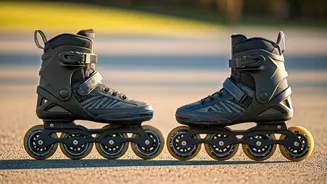Caloric Burn Showdown
When it comes to burning calories, both walking and rollerblading can make a noticeable difference. However, the intensity of the workout significantly
impacts the total calorie expenditure. Rollerblading, given its potential for higher speeds and dynamic movements, often leads to a greater caloric burn compared to walking at a moderate pace. Factors such as terrain (uphill walks vs. flat surfaces), speed (leisurely strolls vs. brisk rollerblading), and individual metabolism play key roles in determining the exact caloric output. For instance, a person rollerblading at a faster pace may burn significantly more calories within the same duration compared to a person walking at a leisurely pace. Therefore, selecting your exercise based on the amount of calories you want to burn is essential.
Muscle Engagement: Walking
Walking is a fundamental exercise engaging various muscle groups, especially in the lower body. The primary muscles utilized during walking include the quadriceps (front of the thighs), hamstrings (back of the thighs), glutes (buttocks), and calf muscles. With each step, the quadriceps extend the knee, the hamstrings and glutes propel the body forward, and the calf muscles help with plantar flexion, allowing the foot to push off the ground. Walking, particularly on uneven terrain or inclines, can further amplify muscle activation. This activity also provides low-impact cardiovascular benefits, improving overall health and stamina. Regular walking strengthens the bones and joints, contributing to good posture and reducing the risk of chronic diseases.
Muscle Engagement: Rollerblading
Rollerblading engages a wide range of muscles, with a pronounced emphasis on the lower body muscles, similar to walking but with some distinct differences. The glutes, quadriceps, and hamstrings are also key players, responsible for the powerful strides and balance needed while rollerblading. Furthermore, the core muscles, including the abdominals and lower back, are activated to maintain stability and control. Rollerblading requires continuous adjustments and balance control, leading to increased engagement of the core and stabilizing muscles. It also provides a dynamic and challenging cardiovascular workout.
Rollerblading's Dynamic Impact
Rollerblading, due to its inherent nature, presents a different impact profile on the body compared to walking. The impact forces experienced during rollerblading are more dynamic because of the gliding motion and the potential for faster speeds. While it can provide an engaging workout, the dynamic nature of rollerblading demands greater joint stability and control. This means that the joints are consistently adjusting and absorbing impacts as the skater navigates turns, uneven surfaces, or pushes off. The use of protective gear, such as wrist guards, knee pads, and helmets is crucial. This gear can minimize the impact forces on the joints and reduce the risk of injury. Ultimately, rollerblading presents a different kind of impact on the body.







